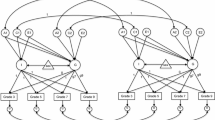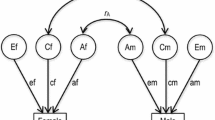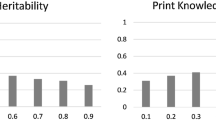Abstract
In order to test the hypothesis that genetic influences are moreimportant as a cause of reading disability in girls than in boys,composite reading performance data from identical and fraternal twinpairs were analyzed using both concordance and multiple regressionmethods. The sample included 206 identical (99 male, 107 female), 159same-sex fraternal (90 male, 69 female), and 117 opposite-sex fraternaltwin pairs, in which at least one member of each pair had readingdifficulties. Although the difference between the concordance rates forreading disabilities in female identical and same-sex fraternal twinpairs was somewhat greater (65% for identical twins vs.32% for fraternal twins) than the difference in concordance ratesfor boys (68% vs. 39%), loglinear analysis of thesecategorical data revealed that the interaction between sex, zygosity,and concordance was not significant (p > 0.70). Moreover,the heritability of reading disability(h 2 g) estimated from regression analysisof the reading performance data in males was nearly identical to that infemales (h 2 g = 0.58 and 0.59,respectively; p > 0.90). Thus, results of this studyprovide little or no evidence for the hypothesis of greater geneticinfluence on reading difficulties in girls than in boys.
Similar content being viewed by others
References
Alarcón, M., DeFries, J.C. & Fulker, D.W. (1995). Etiology of individual differences in reading performance: A test of sex limitation, Behavior Genetics 25: 17–23.
Bakwin, H. (1973). Reading disability in twins, Developmental Medicine and Child Neurology 15: 184–187.
DeFries, J.C. (1985). Colorado Reading Project. In: D.B. Gray & J.F. Kavanagh (eds.), Biobehavioral measures of dyslexia (pp. 107–122). Parkton, MD: York Press.
DeFries, J.C. (1989). Gender ratios in children with reading disability and their affected relatives: A commentary, Journal of Learning Disabilities 22: 544–545.
DeFries, J.C. & Alarcón, M. (1996). Genetics of specific reading disability, Mental Retarda-tion and Developmental Disabilities Research Reviews 2: 39–47.
DeFries, J.C. & Decker, S.N. (1982). Genetic aspects of reading disability: A family study. In: R.N. Malatesha & P.G. Aaron (eds.), Reading disorders: Varieties and treatments (pp. 255–279). New York: Academic Press.
DeFries, J.C. & Fulker, D.W. (1985). Multiple regression analysis of twin data, Behavior Genetics 15: 467–473.
DeFries, J.C. & Fulker, D.W. (1988). Multiple regression analysis of twin data: Etiology of deviant scores versus individual differences, Acta Geneticae Medicae et Gemellologiae 37: 205–216.
DeFries, J.C. & Gillis, J.J. (1991). Etiology of reading deficits in learning disabilities: Quantitative genetic analysis. In: J.E. Obrzut & G.W. Hynd (eds.), Neuropsychological found-ations of learning disabilities: A handbook of issues, methods and practice (pp. 29–47). Orlando, FL: Academic Press.
DeFries, J.C. & Gillis, J.J. (1993). Genetics of reading disabilities. In: R. Plomin & G.E. McClearn (eds.), Nature, nurture and psychology (pp. 121–145). Washington, D.C.: American Psychological Association.
DeFries, J.C. & Light, J.G. (1996). Twin studies of reading disability. In: J.H. Beitchman, N.J. Cohen, M.M. Konstantareas & R. Tannock (eds.), Language, learning, and behavior disorders: Developmental, biological, and clinical perspectives (pp. 272–292). New York: Cambridge University Press.
DeFries, J.C., Filipek, P.A., Fulker, D.W., Olson, R.K., Pennington, B.F., Smith, S.D. & Wise, B.W. (1997). Colorado Learning Disabilities Research Center, Learning Disabilities: A Multidisciplinary Journal 8: 7–19.
DeFries, J.C., Gillis, J.J. & Wadsworth, S.J. (1993). Genes and genders: A twin study of read-ing disability. In: A.M. Galaburda (ed.), Dyslexia and development: Neurobiologic aspects of extra-ordinary brains (pp. 187–204). Cambridge, MA: Harvard University Press.
DeFries, J.C., Olson, R.K., Pennington, B.F. & Smith, S.D. (1991). Colorado Reading Project: Past, present, and future, Journal of Learning Disabilities 2: 37–46.
DeFries, J.C., Wadsworth, S.J. & Gillis, J.J. (1990). Gender differences in cognitive abilities of reading-disabled twins, Annals of Dyslexia 40: 216–228.
Dunn, L.M. & Markwardt, F.C. (1970). Examiner's Manual: Peabody Individual Achievement Test. Circle Pines, MN: American Guidance Service.
Finucci, J.M. & Childs, B. (1981). Are there really more dyslexic boys than girls? In: A. Ansara, N. Geschwind, A. Galaburda, M. Albert & N. Gartrell (eds.), Sex differences in dyslexia (pp. 1–9). Towson, MD: Orton Dyslexia.
Geschwind, N. (1981). A reaction to the conference on sex differences in dyslexia. In: A. Ansara, N. Geschwind, A. Galaburda, M. Albert & N. Gartrell (eds.), Sex differences in dyslexia (pp. xiii-xviii). Towson, MD: Orton Dyslexia Society.
Geschwind, N. & Behan, P. (1982). Left-handedness: Association with immune disease, migraine, and developmental learning disorder, Proceedings of the National Academy of Science 79: 5097–5100.
Knopik, V.S., Alarcón, M. & DeFries, J.C. (1998). Common and specific gender influences on individual differences in reading performance: A twin study, Personality and Individual Differences 25: 269–277.
Knopik, V.S., DeFries, J.C. & Alarcón, M. (1996). Gender differences in cognitive abilities of opposite-sex and same-sex twin pairs with reading disability, Annals of Dyslexia 46: 241–257.
Lubs, H.A., Rabin, M., Feldman, E., Jallad, B.J., Kushch, A., Gross-Glenn, K., Duara, R. & Elston, R.C. (1993). Familial dyslexia: Genetic and medical findings in eleven three-generation families, Annals of Dyslexia 43: 44–60.
Lykken, D.T., Tellegen, A. & DeRubeis, R. (1978). Volunteer bias in twin research: The rule of two-thirds, Social Biology 25: 1–9.
Lyon, G.R. (1996). Learning disabilities, The Future of Children: Special Education for Students with Disabilities 6: 54–76.
Nass, R. (1993). Sex differences in learning abilities and disabilities, Annals of Dyslexia 43: 61–77.
Nichols, R.C. & Bilbro, W.C., Jr. (1966). The diagnosis of twin zygosity, Acta Geneticae Medicae et Gemellologiae 16: 265–275.
Shaywitz, S.E., Shaywitz, B.A., Fletcher, J.M. & Escobar, M.D. (1990). Prevalence of reading disability in boys and girls, Journal of the American Medical Association 264: 998–1002.
Stevenson, J. (1992). Identifying sex differences in reading disability: Lessons from a twin study, Reading and Writing 4: 307–326.
Stevenson, J., Graham, P., Fredman, G. & McLoughlin, V. (1984). The genetics of reading disability. In: C.J. Turner & H.B. Miles (eds.), The biology of human intelligence (pp. 85- 97). Nafferton: Nafferton Books Limited.
Stevenson, J., Graham, P., Fredman, G. & McLoughlin, V. (1987). A twin study of genetic influences on reading and spelling ability and disability, Journal of Child Psychology and Psychiatry 28: 229–247.
Symmes, J.S. & Rapoport, J.L. (1972). Unexpected reading failure, American Journal of Orthopsychiatry 42: 82–91.
Tallal, P. & Fitch, R.H. (1993). Hormones and cerebral organization: Implications for the development and transmission of language and learning disabilities. In: A.M. Galaburda (ed.), Dyslexia and development: Neurobiological aspects of extra-ordinary brains (pp. 168–186). Cambridge, MA: Harvard University Press.
Tallal, P., Ross, R. & Curtiss, S. (1989). Unexpected sex ratios in families of language/ learning-impaired children, Neuropsychologia 27: 987–998.
Vogel, S.A. (1990). Gender differences in intelligence, language, visual-motor abilities, and academic achievement in students with learning disabilities: A review of the literature, Journal of Learning Disabilities 23: 44–52.
Wadsworth, S.J., DeFries, J.C., Stevenson, J., Gilger J.W. & Pennington, B.F. (1992). Gender ratios among reading-disabled children and their sibilings as a function of parental impairment, Journal of Child Psychology and Psychiatry 33: 1229–1239.
Wechsler, D. (1974). Examiner's Manual: Weschsler Intelligence Scale for Children - Revised. New York: The Psychological Corporation.
Wechsler, D. (1981). Examiner's Manual: Weschsler Adult Intelligence Scale - Revised. New York: The Psychological Corporation.
Author information
Authors and Affiliations
Rights and permissions
About this article
Cite this article
Wadsworth, S.J., Knopik, V.S. & DeFries, J. Reading disability in boys and girls: No evidence for a differential genetic etiology. Reading and Writing 13, 133–145 (2000). https://doi.org/10.1023/A:1008020426672
Issue Date:
DOI: https://doi.org/10.1023/A:1008020426672




